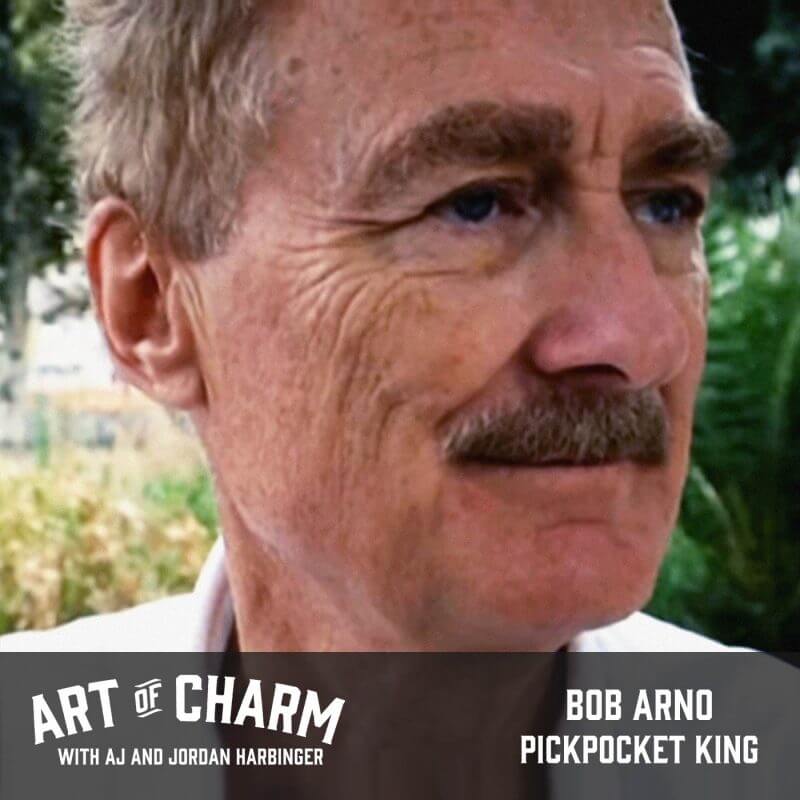Bob Arno (@bambivalent) is a professional pickpocket who uses his powers for good. How? Find out in this episode of The Art of Charm!
The Cheat Sheet:
- How does someone without a criminal background become a pickpocket?
- What are the psychological differences between a mugger and a pickpocket?
- Why do pickpockets tend to spot law enforcement before law enforcement spots pickpockets?
- What kind of shoes should you wear if you don’t want to get marked as a target for pickpockets?
- How should you behave if you catch a pickpocket in the act?
- And so much more…
[aoc-subscribe]
Bob Arno can make you laugh, but he isn’t your average comedian. Tickling your funny bone is just a distraction while he steals your watch and wallet — but it’s all for a good cause: education. With slight-of-hand mastery honed by real-life observation and practice in criminal hotspots around the world, Bob uses his talents to show would-be victims how to avoid being robbed. He’s the co-author of Travel Advisory: How to Avoid Thefts, Cons, and Street Scams While Traveling, and is featured in Pickpocket King, a 2011 National Geographic documentary that shows Bob in action on the streets of Naples, Italy.
In episode 458 of The Art of Charm, Bob will teach us how the psychology of pickpocketing actually works, some of the tricks of the trade that he’s learned, and how we can spot and catch thieves ourselves.
More About This Show
If you hire Bob Arno to speak at your event, his disarming charm will catch your audience off guard. He’ll weave his way through the mesmerized crowd and then back to the stage to reveal his true end game: to steal everything that’s not bolted down, return his ill-gotten gains to their rightful owners, and then teach them how to avoid letting this happen again. The vehicle may be comedic, but its destination is a serious message: no matter how secure you think your valuables are, there’s almost assuredly someone out there who knows how to take it away from you.
Bob wants you to know not only how to spot that someone before they can make their move, but how to stay out of the spotlight as a potential target in the first place. He began his career as a stage pickpocket in the ’50s in his native Sweden, saw his way around the world with a traveling show, and spent a couple of decades prospering as a featured performer on the casino circuit. But as he perfected the moves that made his craft imperceptible to the uninitiated, he realized that he had a calling to do something more with this unique set of talents.
“Stage pickpocketing is unique,” says Bob. “There are very few people who are doing it, so you get a lot of laughter from it. But as one continues and grows and learns more and more, it gets more intriguing how a criminal thinks and how one can teach the world all of this sophistication — how to, I guess, put the pin in the wheel rolling forward and make it difficult for the bad guys.”
Bob’s father was a judge, so maybe it was just a matter of time before the influence of justice would present itself to his career. When he’s not speaking at events to highlight what he’s learned about the importance of security, Bob helps law enforcement research and stay up to date with adaptive criminal techniques — and he was featured in National Geographic’s Pickpocket King documentary, as seen here.
In the documentary, Bob and his wife Bambi travel to Naples, Italy, to find a prolific pickpocket who eluded them a few years earlier. We don’t want to spoil the show for anyone who hasn’t yet seen it, but the adventures they have along the way are as entertaining as they are informative.
Bob notes that pickpocketing thrives in places where unwary tourists congregate — from airports to train stations to cruise ship ports of call. And in cities like Naples, pickpockets work in groups, with each individual assigned a specific role in the operation. A group of three will typically close in on a victim, and the heist looks like this:
- The Blocker boxes in a victim and distracts them, while…
- The Cannon does the actual stealing, and then passes what’s been stolen to…
- The Shade, who takes it and hides it out of sight.
Then, the group will split up. In this way, even if the victim immediately notices their wallet or other valuables missing and goes to confront the person they perceive as the thief (most likely the Blocker), the evidence is long gone — even if law enforcement is called in to investigate.
But how can law enforcement often be so clueless to this and other common pickpocket strategies? One of the main reasons, Bob says, is a disparity in the level of experience between thieves and the police charged with tracking them. While a pickpocket may have been practicing their craft for decades, people in law enforcement are often shuffled between departments every couple of years. Because of this, it’s more likely someone in a group of pickpockets will spot an undercover cop before the undercover cop spots them — and they’ll simply move on to a less surveilled location to commit their crimes.
Listen to this episode of The Art of Charm to learn more about how Bob uses his skills to thwart the bad guys, how he can spot a criminal in the crowd, what you can do to protect yourself against pickpockets, and more.
THANKS, BOB ARNO!
Resources from this episode:
Bob Arno’s website
Thiefhunters in Paradise
National Geographic Documentary — Pickpocket King
Travel Advisory by Bambi Vincent and Bob Arno
The Art of Charm bootcamps
You’ll also like:
-The Art of Charm Toolbox
-Best of The Art of Charm Podcast
On your phone? Click here to write us a well-deserved iTunes review and help us outrank the riffraff!




